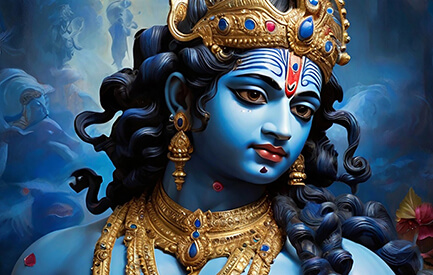
Why is Krishna Blue?
Joyful Blue-Skinned Deity of Hinduism
Krishna, one of the most revered deities in Hinduism, is worshiped as the eighth avatar of Vishnu and the supreme god in many traditions. His significance extends beyond religion into philosophy, literature, and culture, making him a central figure in the spiritual life of millions.
Share this page with a friend!
Why Does Krishna Have Blue Skin?
The name Krishna (Sanskrit Kṛṣṇa) literally means black, dark or dark blue. On a philosophical level, the common depiction of Krishna as having light or dark blue skin is explained as symbolic. His blue skin may represent the infinite expanse of the blue sky. On the other hand, Krishna’s blue skin infers the calmness and depth of the blue ocean.
Blue Blood of Royalty
On a practical level, the phrase “blue blood” refers to royalty or someone who is wealthy, upper class, or highly influential. In many cultures throughout history, the right to rule has been reserved to those who are descended from an existing lineage. In the mythology of numerous ancient cultures, those lineages began with the gods who taught mankind the skills and knowledge needed for survival.
Ancients Gods Depicted with Blue Skin
The deities who brought agriculture, mathematics, architecture, and other advances to early civilizations are often depicted with blue skin. In addition to the East Indian images of Krishna (Vishnu) as blue-skinned, the ancient Egyptians also portrayed beings who were blue in color. Similarly, the Hopi Indians tell of blue-skinned Star Warriors. Some say that the blue-skinned avatars originate from Vega in the Lyra constellation and that this is also the origin of the tern Vedas and Ayurveda. (Thank you to @8dharma8 for this info.)
Origin of the Early Gods
These gods may have been representatives of highly advanced civilizations that did not originate on earth. Some extraterrestrials are reputed to have blue skin including the Andromedans and Sirians. These ancient gods were flesh and blood beings who lived among the people that they taught and ruled. They lived for hundreds if not thousands of years, effectively dubbed as immortal. The question remains: Can humans or human-like beings actually have blue blood?
Watch nearly 400 videos on the Vocal Medicine Channel!
Science of the Blue Blood Hypothesis
Legends all over the world say that the gods came from the sky or from heaven. Is it possible that the physiology of these gods differed from red-blooded humans? Can humanoid beings have blood that differs in color from ours? Let’s take a look at this as a scientific hypothesis.
Species on Earth with Blue Blood
Our oxygen is transported via hemoglobin. Hemoglobin is a respiratory pigment that includes the metal ion of iron. The main purpose of blood is the exchange of gases. Interestingly, iron is not the only metal ion that can carry oxygen. For example, there are some species on earth that utilize copper rather than iron. These species include many forms of sea life: snails, ocean spiders, crustaceans, crabs, cuttlefish, and octopuses. This is called hemocyanin, a reference to “cyan” which is Latin for “blue.”
Why Most Organisms Utilize Iron
Most organisms on earth evolved to utilize iron, partly due to its prevalence. Iron is the most common metal found on earth after aluminum. If an environment contained an abundance of another metallic ion, that metal might be favored for oxygen exchange in the blood. Furthermore, 90% of all iron ingested remains in the body after being ingested rather than being excreted.
The Possibility of Copper-Based Blood
The sun has a high level of copper. Planets created from similar suns might have high levels of copper inn their crust. Our erythrocytes live for 120 days, after which they are replaced. Organisms that have copper-based gas exchange in their blood would need to replenish their systems with copper just as we constantly need to have iron-rich food.
Diet for Replenishing Copper
If the “gods” or ruling elite had copper-based blood, they would require a diet high in copper. An agricultural, grain-based diet is low in iron but rich in copper. In contrast with this, the Neolithic hunter-gatherers on earth had a diet rich in iron: meat, berries, and root vegetables.
Sky Gods and Agriculture
Many legends report “sky gods” who came to earth and taught agriculture. Some stories say that people preferred their hunter-gatherer lifestyle but the rulers insisted that they take up agriculture. The move to agriculture actually increased the level of labor necessary to obtain subsistence food. Ethnographic evidence indicates that only about three hours a day were needed to secure food for hunter-gatherers. Instead, agriculture became a full-time occupation.
Pressure Towards a Grain-Based Diet
Even agriculture based on raising root vegetables rather than grain yields ten to one hundred times greater productivity. External pressures may have influenced this shift to predominantly raising wheat if the ruling class needed bread rather than iron-rich foods. Some indigenous peoples resisted this change for thousands of years.
Aliens with Blue Skin in the Movies
In modern movies and pop culture, the presence of blue aliens continues to fascinate us. Who knows if there is a kernel (no pun intended) of truth in the lore of blue-skinned deities, gods, and aliens? A brief list of movies featuring blue aliens includes Avatar, Guardians of the Galaxy, The Fifth Element, Megamind, and multiple Star Trek productions.
Another Approach to Krishna's Blue Skin
Relayed by Endless Lugo, subheadings added
“Love your channel Kathleen, long-time follower and subscriber! I’ve heard the copper, plant, and star-being references, and I can’t rule them out! I’d love to offer a different angle that I’ve also contemplated for a while and hear your opinion. I’ve only heard the general basis, of what I will share, from the prominent Sadhguru when he was once asked about Krishna and others’ blue skin colors.
Meaning of the Term Blue-Black
So, I am black American. In my culture, we have a term that we use called “blue-black” to physically describe some of the darkest-skinned people in our communities. It’s meant to be an endearing term. Most common in the south of the United States due to migrational history, some American people are so dark that they have a slight blue tint in their skin under sunlight and some other light sources. It’s a unique feature, so much so, that not every darker-skinned black/brown individual has it. Hence, we call them blue-black, if such a response or expression is solicited.
Variations of Blue-Black
Sometimes, one may be nearly black-skinned, without the blue-tint at all, instead expressing a red tint or an earthy soil/bark brown tint as can be expected. In the proximity of the Indian landmass are the Andaman Islands. The Andaman Islanders are an indigenous people and, mostly, uncontacted, are a dark-skinned Asian population. Their genetics are closest in relation to Indian and Australasian populations.
Ancestral Indian Populations
By skin-color description, rather than genetics, my people would describe some Andaman Islanders as blue-black [Asians] because of the blue-tint that is sometimes present in their darkest and nearly-black complexions. So, as one could imagine, a part of me thought that maybe Krishna and some others could have been depicted with the blue-black skin comparable to the Andaman Islander relatives of some ancestral Indian populations.
Skin Colors Attributed to Krishna
Especially since Krishna has been depicted with black skin, and even less frequently, dark-brown skin. When Sadhguru was asked about Krishna’s complexion in front of an audience, his response implied that he preferred not to speak too much of such things for the material nature that may come with the question, and he went on to say that Krishna can be found with various skin colors throughout Indian history and that the timeline of it all may have impacted it.
The Mystery Remains
He went on to shortly say in closing, that the lighter-blue and whitening in some of the cases may have been for “racial” reasons. Sadhguru then moved on from the question. He did not ever say what Krishna’s original skin color was, and, as Sadhguru probably felt, I, myself, don’t believe it should matter and be dwelled upon much.
African Populations
Also, just to add, there are some populations in Africa that have blue-tinted individuals like the generally Nilotic Africans, and the Kaba, Hausa, and more western, Senegalese tribes like the Serer/Seereer tribe. What do you think of any of this? I’ve always wanted another opinion.
Conclusions
I hope you can excuse the controversial nature of this take… It took me some courage to even bring this up to you here on your thoughtful and mindful video and, admittedly, aesthetically pleasing channel. Very lovely vocals as always, much gratitude for sharing your gift with us! I’ll continue to sing along, as I have been doing all this time. Excited for what more there is to come!”
Response (Kathleen Karlsen)
Hello! I think it is incredible information, and I am deeply grateful to you for sharing. I have heard the term as a dear friend refers to herself affectionately as “blue-black.” However, I did not know any of the history that you have described, which is quite thorough.
I would like to include some of this on my website as I have a page dedicated to Krishna that currently includes the info in this video. I agree completely that the skin color is literally a surface issue. We are souls. We are spirits. We come from a divine source, and that is our identity.
I pay attention and find intrigue in such details as Krishna’s depiction with dark skin because it leads deeper into the ancient stories where the seeds of truth may lie. A professor here at Montana State University (Bozeman) once said, “For facts, look at history. For truth, study mythology.”
Author Kathleen Karlsen
Kathleen Karlsen is a musician, artist, writer and speaker. She is the author of two books (Flower Symbols and Vocal Medicine) and over 200 articles. Kathleen, her husband Andrew, and their five children live in Bozeman, Montana. More about Kathleen Karlsen.
Krishna Article Summary
Krishna widely revered among devotees around the world. Krishna is known for the qualities of compassion, tenderness, protection and love. This article includes an in-depth discussion with possible answers to the question, “Why is Krishna’s skin blue?”





